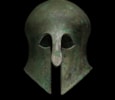Corinthian Helmet
A bronze helmet made of a single hammered bronze plate in the characteristic shape of the military Corinthian type helmets of the end of the 7th century and the beginning of the 6th century B.C.. The type is defined by the characteristic almond-shaped eyes, elongated nose guard, and two integrated cheek guards that terminate in sharp points. Two highly stylised ‘eyebrows’ swoop dramatically above the eye holes, and all the edges are lined with three rows of engraved border. Two small holes for attaching a chin strap are pierced in the corners of the cheek guards.
The Corinthian helmet is arguably the most iconic of Greek helmet types, and is the one depicted on more sculpture from the period than any other helmet – suggesting the ancient Greeks may have associated it already with a glorious past. By the late 7th-early 6th century B.C., this type of helmet predominated due to the high level of protection it offered, with only a small T-shaped area of the face visible, and its sturdy construction from only one sheet of metal (previous helmets were formed from two halves joined together). From 550 B.C. onwards modifications were added to Corinthian helmets in order to reduce injuries leading from concussion and piercing blows. The nose guard was increased in length, the eye holes decreased in size, and the cheek pieces were elongated and brought closer together. Combined with a more domed skullcap, these features provided greater protection, albeit at the cost of sensory perception. This style of helmet is referred to a the lotus group, and is often characterised by swooping eyebrows and floral motifs.
Helmets and other types of armament were frequently dedicated to gods in sanctuaries, with even the Homeric heroes vowing to donate captured weapons. Most often, these represented spoils of war, as a conquering city would consecrate the weapons of the conquered; for instance, the Syracusans donated the weapons of the Etruscans they defeated at Kyme in 474 B.C., according to the inscriptions on the captured objects in the sanctuary of Olympia. Less common were donations from retired hoplites (heavily armoured warriors), who sought to give thanks to the gods who protected them during their career. Victors in athletic competitions would also bestow gifts of armour to the gods.
With Terra Design, Xanten, Germany, by at least 1979.
Private Collection of Joost Kuizenga (d. 2019), Enschede, Netherlands, acquired from the above on 8 May 1979, accompanied by handwritten logbook.
Thence by descent to his wife and son, Enschede, Netherlands.
ALR: S00247678, with IADAA Certificate, this item has been checked against the Interpol database.










 Enquire
Enquire




